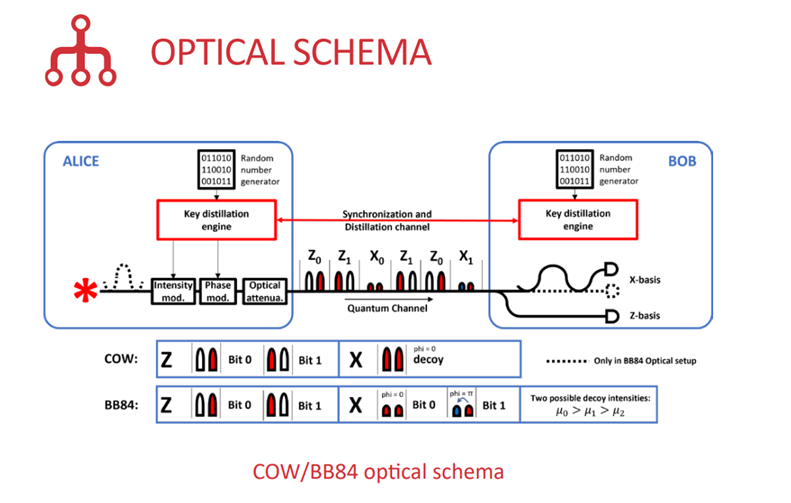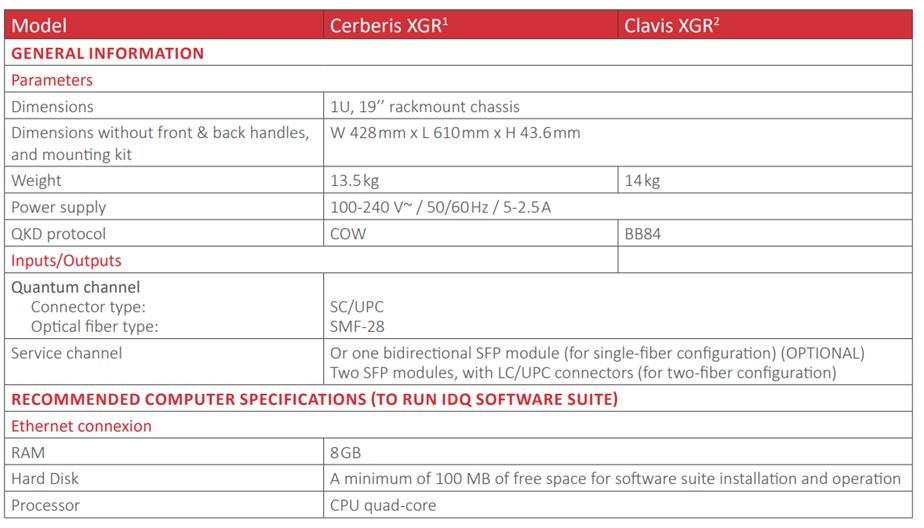The XGR Series Quantum Key Distribution Platform was developed by ID Quantique to serve as a versatile research tool for both academic and technology evaluation labs. The user can therefore experiment different parameter set-ups and configurations, in both automated and manual modes.
Secure key exchange is possible over fibers with a maximum loss of 12 dB to 18 dB (typ. up to ninety kilometers) for a Cerberis XGR pair or 24 dB (typ. up to one hundred fifty kilometers) for a Clavis XGR pair, as well as over a single core using WDM. The optical platform is well documented in scientific publications and has been extensively tested and characterized.
The XGR Series also integrates a Key Management System (KMS) that manages key requests and key transfers between QKD optical systems and external encryptors. Key distribution to encryptors or any key consumer is performed over the secured QKD ETSI REST API or proprietary interfaces developed in partnership with major vendors.
A comprehensive software suite implements automated hardware operation and complete key distillation. The IDQ4P protocol of the XGR Series (the proprietary communication protocol used for key transmission and management of the XGR platform) can stream out the sifted Keys before the QKD post processing is applied (esp. the error correction). Those keys correspond on Bob side to the detection values and on Alice side to the Qbits that were sent for those specific detections. With the sifted Keys the user can compare the two streams and verify the QBER of the system.
KEY DISTILLATION
After the raw key material has been exchanged, it is first sifted to remove all undetected pulses and all unusable detections. Then, it is post-processed in order to correct errors and reduce the information to which an eavesdropper could have access to an arbitrarily low level. In the XGR platform, this process is fully implemented and automated to allow secure key exchange. It consists of five main steps:
Sifting: sifting removes the bits, which cannot be used in the key itself (for example when decoy sequences are sent).
Key reconciliation: key reconciliation relies on the Low-Density Parity Code (LDPC) algorithm to remove errors; it is also used to estimate the bit error rate.
Privacy Amplification: PA uses the Wegman-Carter Strongly Universal Hashing to reduce the information, which may have leaked to an eavesdropper, to any chosen level. The set of Universal Hashing functions is constituted of Toeplitz matrices.
Authentication: authentication of the two stations is done through IT-secure polynomial Universal-Hashing with One Time Pad encryption.
Key material storage and management: the final keys are stored and can be later accessed for verification, key usage, and further analysis.
SOFTWARE SUITE
Graphical User Interface for configuration, parameter setup and monitoring
The XGR Series’ QMS Web application is a graphical interface application that can be used to control and operate the XGR platform. It provides access to some hardware parameters and allows the user to visualize processes ranging from system calibration to secure key exchange. It also allows to configure links between QKD and encryptors, to monitor the XGR systems and manage the XGR Devices’ Firmware's.
IDQ4P Communication Protocol for key streaming and key management
The IDQ4P Communication Protocol is the proprietary communication protocol used for key transmission and management of the XGR platform. Users can write customized programs accessing the system to perform the tasks required by quantum key distribution. The protocol defines a key channel for the streaming of indexed keys and management/ control channels for startup/shutdown, SW/ FW updates, system notifications including events and alerts.
QNET WebAPI for automated management and monitoring
The QNET REST WebAPI used by the GUI can also be used directly to configure and monitor the XGR Devices.



